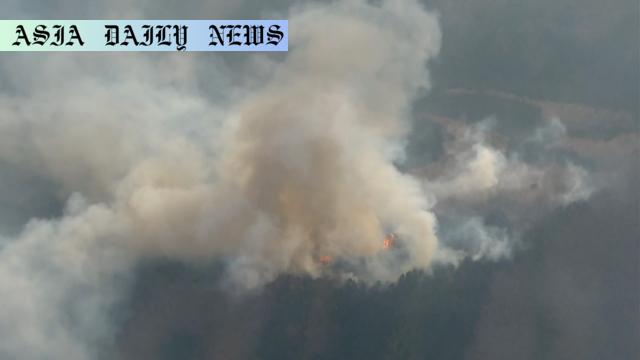Wildfires continue to spread in Iwate Prefecture, northeastern Japan, forcing over 1,200 people to evacuate as the blaze grows.
- Wildfires in Iwate Prefecture have burned 1,800 hectares in northeastern Japan.
- Over 1,200 people evacuated, with at least 84 buildings damaged.
- Efforts by Japan’s Self-Defense Force and firefighters continue to battle the blazes.

Wildfires Devastate Northeastern Japan
In recent days, wildfires have wreaked havoc in Iwate Prefecture, located in northeastern Japan. The fires, which began on Wednesday in the city of Ofunato, have now burned through approximately 1,800 hectares of forest as of Sunday morning, marking an expansion of nearly 400 hectares in just 24 hours. This catastrophe poses an ongoing threat to residents and property in the region as firefighting efforts continue tirelessly.
The local government has intensified its response, with aerial and ground crews working around the clock to suppress the spread of the fire. Helicopters from Japan’s Self-Defense Force have been deployed to drop water over the affected areas. However, progress remains challenging due to thick, billowing smoke heading toward residential areas. The situation grows more dire as authorities scramble to protect lives and homes.
Humanitarian Impact and Property Damage
As the flames rage on, over 1,200 residents have sought refuge in emergency shelters set up throughout Ofunato City. The safety of these evacuees remains a primary concern as conditions in their neighborhoods continue to deteriorate. Tragically, a body thought to be that of a man was discovered on Thursday, underscoring the deadly nature of this disaster. To date, reports indicate the destruction of at least 84 buildings, though an accurate assessment will require time as the fires persist.
Efforts to control the wildfires have encountered several obstacles, including dry weather and strong winds. Firefighters are working closely with local officials to evacuate remaining residents in high-risk zones. Sustained operations are underway to ensure both short- and long-term recovery for affected communities.
Challenges Ahead in Containing the Blazes
The severity of the wildfires highlights the resilience and determination of those combating the disaster. With continuous support from the Self-Defense Forces and local firefighting units, authorities are examining strategies for mitigating such risks in the future. Areas near forests face elevated hazards, with smoke threatening to escalate public health problems and fire embers risking further outbreaks.
Assessment of the wildfires’ environmental impact is also critical, as burning vegetation leaves long-term scars and disrupts ecosystems. It remains evident that recovery from this crisis will demand extended resources, community cooperation, and a strong commitment from local and national entities to restore the region’s stability and prevent similar events.



Commentary
The Importance of Swift and Coordinated Response
The wildfires currently devastating northeastern Japan are a reminder of how rapidly natural disasters can escalate. Watching this tragedy unfold underscores the importance of a well-orchestrated response. Japan’s quick actions, such as launching aerial fire suppression efforts with helicopters and establishing emergency shelters, demonstrate a level of preparedness that other regions could learn from.
However, the extent of the damage speaks to the difficulty in combating nature’s fury once it is unleashed. Over 1,800 hectares destroyed and 1,200 individuals evacuated is a grim toll. While the heroic efforts of Japan’s Self-Defense Force and firefighting units have undoubtedly saved lives, it will take time to assess the full impact of this disaster on residents and local ecosystems alike.
Long-Term Implications and Lessons Learned
This current disaster serves as a stark lesson about preparedness in the face of climate-driven catastrophes. As global temperatures rise, wildfires are becoming more frequent and intense. Nations must invest in robust infrastructure and emergency systems to combat such threats while working to mitigate climate change. Advanced technologies, like satellite monitoring and drones, could further bolster firefighting capabilities, improving both response times and situational awareness.
Additionally, it is critical to reduce human vulnerability by enforcing stricter regulations on fire-prone regions and ramping up community education programs. Governments should empower individuals with knowledge about fire prevention and evacuation procedures, ensuring readiness for events that may occur with little warning.
Solidarity in the Wake of Disaster
Finally, these wildfires remind us that solidarity remains pivotal during times of crisis. Communities have come together in Iwate Prefecture to support one another, offering shelter, food, and comfort to those in need. The collaborative efforts of residents and emergency crews alike provide a beacon of hope amidst destruction. As rebuilding begins in the weeks to come, such unified efforts will pave the way for healing and recovery.